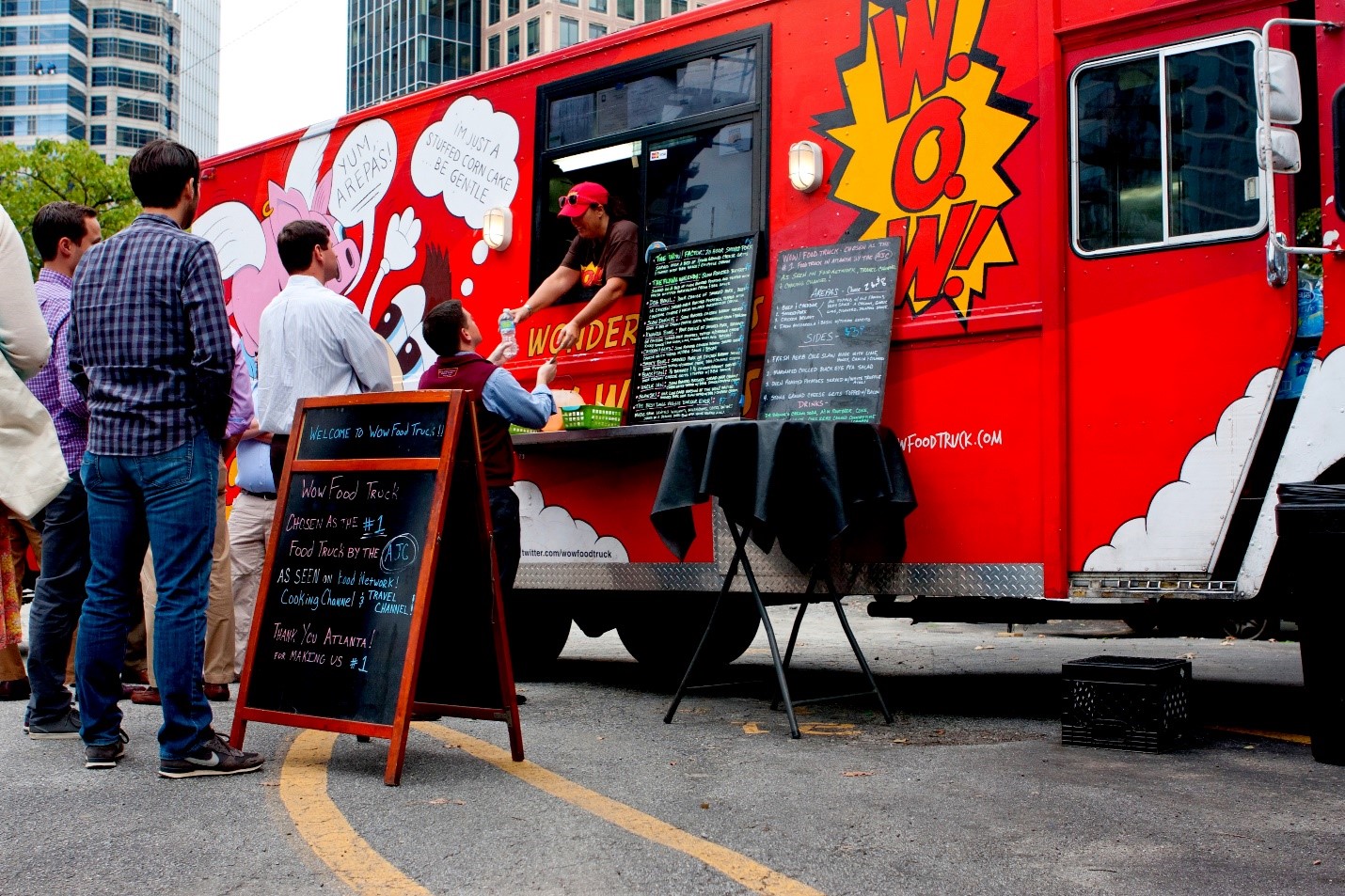We had been aching to write something about starting a food truck business for so many reasons.
Call it the lingering sensation of feeling awkward when you reach down into the dark abyss of Google archives to get advice on starting a small business. To be honest, that’s the worst thing you can do. Part of the reason for not recommending Google search results for any sort of business consultancy is the SERP itself.
For instance, when we typed down: “how to start a food truck business” in Google search bar, the results were baffling. There are literally webmasters out there who recommend starting a food truck business in 8 – 9 “easy” steps!

Really? It is that simple?
Of course, it isn’t.
Mastering an XYZ step guide on starting a mobile street food business means that you could be making your first million bucks by the end of the week, right?
There’s no way for a small blog to sum up entrepreneurs’ hard work, lessons learned in grit, and the epitome of advice in 8 – 9 “easy” steps.
But then again, there’s always the underdog out there who wants to make a name in the food and beverage industry. We, at Blink, do it for the ordinary Joe. Why? Because, at the end of the day, it’s the small business community that matters most to us.
So, here’s to hoping that you stumble upon this brutally honest guide on starting a food truck business. We will give you the knowledge, sans any expectations because that’s what honest content curation platforms do.
Anyone else promising you that you could pull an easy $70k, or AED 100K gig by setting up a yogurt shop somewhere in the metropolis is just doing it for the sake of web results visibility. Don’t feed these guys, and share such posts.
It’s a waste of time that eventually leads to someone foolhardy enough to blow their hard-earned savings on setting up a venture in X number of steps.
How to Start Your Very Own Food Truck Business as an Ordinary Aspiring Entrepreneur?

This write-up elaborates on real-life talk, solid advice, and lessons that failed and successful food truckers have shared with us over the past few months.
It’s the brass tacks, garnished with a nice seasoning of Do’s and Don’ts of starting a mobile food street business to help you down the path.
So, let’s get to it.
Food Truck Business Isn’t an Easy Job:
Starting a small-scale business is not that easy. Your hours are not defined, there are slow days that just don’t work according to that near-perfect business plan of yours, and sometimes you need to commit to it without any hopes of flipping profit for a few months.
At the start of your food truck business venture, it’s best that you get some culinary experience. If you already know how to flip burgers, rustle up sandwiches and play around with chicken finger fries, that’s good.
But the important thing is prepping up way in advance before the gig starts.
While we do understand that the excitement of starting a small-scale food truck business is too darn enticing, it’s best to wait it out a bit until you have learned the basics of the business. The best way of doing so is to have a real one-on-one conversation with all kinds of food truck businesses in your local vicinity.
Former business owners will share nuggets of advice with you that they learned the hard way. It’s the type of knowledge that you don’t find easily in Google search engine results.
Have a sit down with designated people from the mobile food services community, and see what they have to share. Don’t forget to take notes for references afterward.
[INSERT_ELEMENTOR id=”2061″]
Unique Business Advantage
Your business truck needs to have a theme; something that has the jazz quartet equivalent to attract customers from a mile away. If it’s burgers, think about adding a twist to your family heirloom recipes that none of the other food truck businesses are producing at the moment.
Early Startup Cost Associated with Launching a Food Truck Business
The bare minimum cost of buying a food truck is somewhere between $55,000 to $75,000. Top it off with insurance plan coverage and modification costs because you will need to make a few adjustments to slide in your mobile kitchen.
The alternative cost-effective approach to owning a food truck is by buying a used vehicle. These trucks are available at half the price of the brand new models out there. However, used trucks have their own shenanigans. Sometimes, they break in the middle of nowhere. Have a toolkit by your side and an emergency toll driver’s number in case of the worst-case scenario on a rainy day.
Another great option for getting your hands on a food truck is by getting a truck on a lease agreement. This way, you can save money by streamlining the expenses on staff fees, overhead billables, and other unexpected changes that need to be paid in full on a certain date. A rental food truck will cost you somewhere between $2,000 to $4,000 per month.
Moving on, there’s the cost of food preparation equipment. On that note, we’d recommend buying the necessary stuff because you don’t have to overspend on utensils that won’t be used for months on end. Relate the cost of food preparation equipment to your mobile food order menu to have an idea about what sort of equipment you need to get started.
Having a Sound Visual Theme for the Food Truck
Looks matter. Period.
The fact that people will be relating to your food truck business based on the first impression really matters. You don’t expect a random dude to pull up a hardware truck on the street to serve customers with hot bagels.
Try to center your food truck business’s visual theme around your unique selling proposition. If you have the best burritos in town, alongside $3 potato and steak, what does your truck say about it?
People DO NOT take that much time out of their lives to read advertisements plastered on billboards. We are already running on an attention deficit, so why waste time reading walls of texts on a billboard?
The food truck visuals need to be bold, simple, and easy enough to convey the message. Complex drawings also skewer customer’s interpretation. Therefore, there’s no need to play around with abstract styles when you can get someone to paint a simple message with a spectacular mascot or some other visuals that resonate with the type of food you are selling.
Ideally, people should have an idea about your menu BEFORE they even get a chance to go through it. That’s where visuals come in.
Payroll Expenditure, License and Permit Fee, and Vice Versa
A food truck business is not your average 9 – 5 Hours job.
Yes, there are so-called entrepreneur advice platforms that suggest that owning a mobile food street business on the “side” requires only a few extra hours. That’s just not true.
The plain and simple fact of owning a food truck business – and that too, as an entry-level start-up entrepreneur, who has no priors, means long hours, committing to the objectives, and driving around from one location to another.
Also, you will be on a daily time crunch to prep for the next day. Many food truck businesses have their actual kitchen somewhere else. By the end of each day, the business owner needs to go to his kitchen to prepare the ingredients for the next day – so on and so forth.
We hope that the air is clear now.
Let’s see the cost tangent of acquiring licenses and managing a small staff for your food truck business.
On License and Permit Whereabouts:
If you are in the U.S., you can visit your city’s local website to seek information about obtaining a license for a small food business.
If you are not sure about the contact information of the concerned department, call your local public service communities to get in touch with someone who can point you in the right direction.
- On License and Permit Fee:
Official approval for food truck business is available from the U.S. Board of Health.
Get approval from the Board of Health and pay for a license to operate your mobile street small food business with peace of mind.
All the more, your customers will feel confident in knowing that you’re a legit business owner whose food is approved by the health regulatory committee, and vice versa. The good news is that the actual license cost will be somewhere around $100 – $800. This includes your application fee and details pertaining to license/ approval expiry.
The only “hindrance” to obtaining official approval for the food truck business is the documents and a scheduled, or surprise visit from a food inspector.
These are the documents that you need to present to competent authorities for obtaining a license for your food truck business:
- Proof of identification
- Proof food equipment, food items, and mobile food unit purchase, rental, etc.
- Evidence of meeting fire code compliance
- Proper food storage units
- Copy of a district food manager identification card
If you are based in the Middle East, or somewhere in the MENAP region, contact your nearest food administrator to get started.
[INSERT_ELEMENTOR id=”2061″]
Our Best Advice on Managing Hired Help Payroll for your Food Truck Business:
The best way to mitigate high payroll rates is by starting small with your friends and family members. If you have a cousin, an aunt, or maybe one of your siblings willing to lend a hand in your small business venture, go for it.
Your family members and loved ones are people with whom you can negotiate. Unlike professional food truck chefs, you can define wages over a preset number of sales. If you fall short, you can make up for it in the next payroll – so on and so forth.
However, family members helping you with a food truck business isn’t a dream come true situation for every single entrepreneur out there. If you have to rely on splitting cheques between professional co-workers, observe the following scenario:
If you are starting with 3 – 4 people as hired help in your food truck business, the stubs need to be divided across $400 – $500 daily. This means that to break even on wages, alone, you need to sell 60 – 70 servings on the current profit margin of a $7 food menu order.
The $7 price does not factor in smoothies and other beverages. Your customers will order drinks if they are looking to buy fast food from you. Therefore, your struggle to reach the break-even point will stick out like a sore thumb.
What’s the best thing you can do? Hire “0” people and prepare in advance for daily meals at a nearby kitchen on lease. Such kitchens operate in different local vicinities where lots of name-brand mobile street food operators come in to prepare their food – and be on their way.
Securing Locations for Food Truck Business:

Securing a location is like striking a gold vein.
The best spots are corner streets, intersections, and public welfare gatherings. You can set up shop near the first two location categories, it’s the third one that grinds our gears.
Securing a location for your food truck business near auctions, public meetups, local town fares, etc. is the perfect opportunity for you to make money on the side. Now, a lot of times, these community gatherings won’t charge you and let you operate on a whim because you are doing them a service.
If you are looking to pull up near such a location during the summer season, there’s a high chance that they’ll appreciate your “kind gesture.” Small gatherings will let you operate for free. Big ones will probably have somebody contact you to draw up a small agreement that states down your “rental” cost for providing F&B services.
Either way, it’s a good way of making a dime in a day or two.
On a separate note, parking at roadside locations is a hit and miss. Sometimes, there’s no traffic. Other times, you will be asked to relocate due to security hazards.
Fun Fac: Securing location at night – and that too, outside a bar is probably the best thing that can happen to your business. There’s nothing better for a drunk customer to discover a food truck operating during the wee hours of the night.
Best case scenario, these customers will tell stories about you, if you are able to save their night like that!
Why Didn’t We Mention Anything about a Food Truck Business Plan?
To be honest, we have already written an in-depth guide on how to create your food business plan from scratch. It’s a detailed guide with all the shindigs on gathering funds, your food business’s executive summary, investment portfolios, and vice versa.
If we were to write about creating a food truck business plan in this post, it would have been like regurgitating dated tips without sharing anything new. So, scroll over to our ‘How to Create a Killer Food Business Plan’ post and find out what you’ve been missing out on.

Food Truck Menu Management:
Menu management is all about pricing your food right. It’s rare for food truck businesses to print a paper-based menu because they post everything in illustration format on a billboard that goes on the top.
Such food trucks usually have a 2 page printed pamphlet-sized menu that’s kept as a backup for customers who want to see the menu. Nonetheless, our point is not the menu orientation or how you position it outside your food truck. It’s the pricing structure of your food order menu that needs attention.
At lunchtime, people want something quick and easy to carry. A $10 meal is best during lunch hours. Likewise, late-night folks usually go for a drink and a meal because it’s well past normal work hours. Impulse also kicks in and people buy more than they could chew. However, it’s a profitable turnover for you.
Your menu needs to be flexible and multi-tiered as far as pricing is concerned. There should be an assortment of cheap food and high-end meals that are “expensive”, but not that expensive to dissuade your customers.
Know Your Seasons & Customers:
Food truck businesses reportedly see a slow sale season starting from the end of December to Mid February. We think that the reason for slow sales is people burning out during the holiday season on high ticket items.
You, on the other hand, are just a vendor with affordable street meals. Therefore, people can look to dispose of your services over other services for the time being. For mobile food street businesses, the best time for things to go on a roll is during the Summer seasons.
Most of your customers will be from construction yards, corporate parks, joggers, and jaywalkers who need a dab of that food with something to wash it down with.
What’s Your Take on Starting a Food Truck Business?
If you haven’t started a mobile food street business, what’s holding you back?
If you have already dabbled in such business ventures, we’d love to know the lessons you have learned so far. After all, nothing beats advice based on solid real-life experience. Your comments will help small business owners who rely on honest feedback from people.
We look forward to hearing from you.
Related Articles:
 5 Best Restaurant Promotions that Work for BlinkCo.’s Clients
5 Best Restaurant Promotions that Work for BlinkCo.’s Clients
 Delighting Customers The Right Way; 7 Best Tips
Delighting Customers The Right Way; 7 Best Tips
 Restaurant Social Media Marketing; 5 Best Strategies For New Businesses
Restaurant Social Media Marketing; 5 Best Strategies For New Businesses
 Restaurant Guide: How To Convert Third Party Customers To Direct Ordering?
Restaurant Guide: How To Convert Third Party Customers To Direct Ordering?
 5 Important Restaurant App Features You Need To Scale Your Food Business
5 Important Restaurant App Features You Need To Scale Your Food Business




